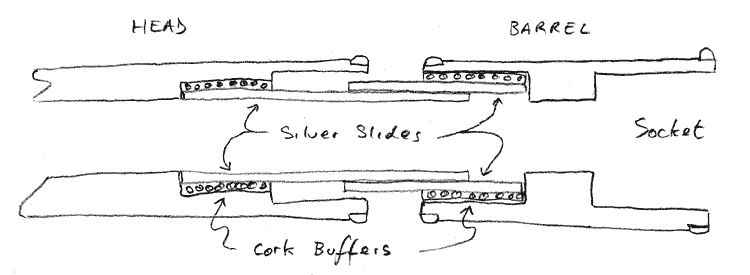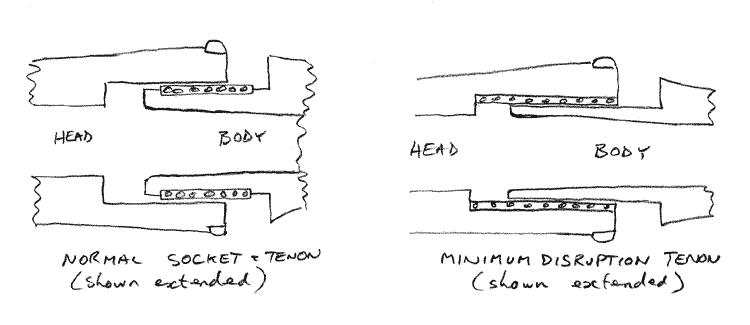The issue
The best way to adjust the overall tuning of your flute is the metal
tuning slide. But they cost money. Is there any way
we can
tune our flutes without a metal tuning slide? Why can't we
just
pull our flutes out at the socket and tenon joint at the top of the
body like recorder players do? Let's find out ....
The normal tuning slide
Supposing
you withdraw a normal tuning slide say
10mm
(3/8"). Because the walls of the inner slide are not
infinitely
thin, it introduces a small
disruption to the bore - about 11% increase in bore area over that 10mm
in length.
Fortunately, the impact is very minor and, under most circumstances,
not noticeable. (The 19th century maker Siccama however
provided a sawn-off section of tuning slide to fill that tiny gap.)
You
can
see the gap introduced here in the image below, where the arrows to the
right of "Silver Slides" point.

But at the socket?
Do
the same by
pulling out the head at the tenon and socket joint at the top of the
body though, and the increase in
bore area and consequent impact is much greater - typically about
53%. You
can get
away with a few mm of such disruption, but a 10mm extension achieved
this way
would introduce very noticeable problems in accuracy and efficiency.
I've
come up with a new tenon-socket arrangement
specifically
designed to minimise this disruption (hence the grandiose name!); its
impact will be
about 30%. That's less than halfway between the disruption
caused
by normal
slides and the normal socket-and-tenon joint, and so permits the tenon
to be
withdrawn much more for the same overall level of disruption.
So
if you
are forced to do without a tuning slide, the Minimum Disruption Tenon
could well
be
the way to go.
You can see the normal arrangement on the left below, contrasted with
the Minimum Disruption Tenon on the right.

In
the traditional arrangement (which is fine
when you have a tuning slide), the cork or thread lapping is on the
outside of the tenon. Consequently the bore of the socket has
to
be big enough to accept all that.
In
the MDT (note the sneaky introduction of the
acronym, as if it had been around since the dawn of time), the tenon is
made much thinner, about the same thickness as the bottom of the
lapping trough. The cork is installed on the inside of the socket,
instead of the
outside of the tenon.
So
you can see by comparing the images above, when the tenon is drawn out
to tune the flute, the cavity created has a much smaller
volume.
Strong enough?
You
might wonder if a thinner tenon can
stand up to the forces imposed on it when inserted into the corked
socket. Indeed it can and easily. Wood is truly
wonderful in
compression (e.g. railroad ties/sleepers), and can withstand enormous
pressure. Wood is a bit like people - it achieves its best
under
pressure, but easily comes apart under tension.
Neat and firm, too.
A
visual advantage is that when the MDT is
extended, no lapping
cork is visible (remember, the cork is on the inside
of the
socket, not the outside
of the tenon). The late 19th century flutemakers pulled a
similar
visual trick with their integral slides and tenons by putting the cork
only at the front of the tenon.
But
you'll also find that the MDT is firmer (ie
rocks less) than the normal arrangement when extended. You
can see why from the
sketch above - all of the tenon inside the socket is supported by cork,
not just some of it.
And light!
For those who find holding a flute up for long periods difficult, the
MDT approach also has a pleasant surprise in store. A keyless Grey
Larsen Preferred model in Mopane weighs in at just 246 grams - less than
8.7 ounces. Compare that with a typical English 19th century flute
at about 410gms - just 60%.
Belt and
braces
Finally,
if you do find you are one of those very
sharp
players that needs the tenon well extended, we can supply a "tuning
ring" to your specifications to take up the internal space - et
voilá - no
disruption at all! (Actually, we'd recommend making the
tuning
ring just a
little short of the extension you normally play at, leaving a little
room for
tuning sharp if needed while still taking advantage of the ring.)

Business end of a "Grey
Larsen
Preferred" model in Mopane, with the head withdrawn
to reveal the clean appearance of the Minimum
Disruption Tenon.
Exeunt slides?
Does
the MDT make tuning slides a thing of the
past? I
think not.
But
if you're up against a tight budget, and
particularly if this is not your everyday flute, it's a great
improvement over
just pulling out the normal tenon and socket, especially when it
enables you to
buy a better quality flute than you might otherwise have been
able. Or to add
a couple of keys you couldn't otherwise afford. It might also
make sense for a flute that you don't expect to be your main
instrument, eg a flute in Eb or Bb.
Buy Now!
Heh heh, steady on, this isn't Ebay! But if you are interested in
a flute employing the MDT rather than my New
Improved Tuning Slide, you'll see the relevant prices in the
section of my price list marked "without
tuning slides".
|